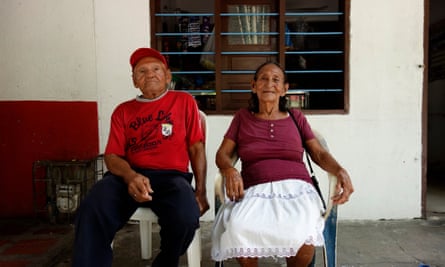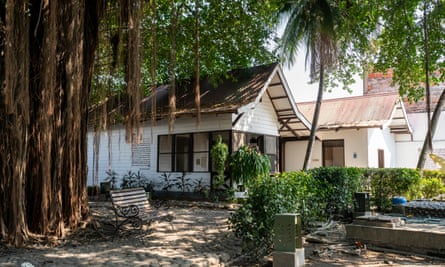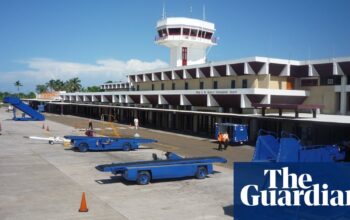In sweltering mid-afternoon heat, children splash in the clear water of the canal that threads through town as elderly neighbours look on from rocking chairs on the porches of their sun-washed houses. Butterflies spring from every bush, sometimes fluttering together in kaleidoscopes.
At the foot of Colombia’s Sierra Nevada mountains, about 20 miles from the Caribbean coast, Gabriel García Márquez’s fictional world of Macondo lives on.
The sleepy town of Aracataca (population 40,000) might well have remained like many others across Colombia’s coastal hinterland – hot, dusty, poor and unknown to the rest of the world – were it not for the inspiration it gave the author for the fantastical setting of his 1967 novel One Hundred Years of Solitude.
García Márquez was born here and lived in the town until age eight with his maternal grandparents. The author, known in Colombia as Gabo, later said all his writing drew on that time, none more than the book that came to exemplify magical realism. By blending the fantastical with the everyday to show the comical, farcical and often tragic nature of life in Latin America, Gabo gave the region a voice and captured hearts across the world.
“Exactly what is the key still escapes me after all these years but somehow his poetry and plot portray the tropics in a powerful and universal way that reaches people’s hearts all over the world,” said Jaime Abello, director of the Gabo Foundation, which promotes García Márquez’s literary legacy.

Now, locals hope that a Netflix adaptation of One Hundred Years could make Aracataca what Dublin is for James Joyce or Stratford upon Avon for Shakespeare. The first eight of 16 episodes are expected later this year in what could become one of the most expensive TV productions in Latin American history.
Some locals feel betrayed that the series was not filmed there. Instead, it was shot in the industrial city of Ibagué, 430 miles to the south. “We’re disappointed that Netflix decided not to film here, but we all know that anyone inspired by the series will have to come to Aracataca, as the heart of Macondo lies here,” said Robinson Mulford, a local high-school teacher. “They will feel the kindness, the solidarity of the people, and everything else that Gabriel García Márquez said of the Colombian Caribbean. They will all be received with love.”
Nowadays, there are few opportunities in the town apart from working in surrounding banana and palm farms, although a handful of guides and shops scrape a living from the modest stream of tourists who make the pilgrimage to Aracataca.
Images of Gabo’s smiling, moustachieod face are to be found on almost every street, and statues of the author and his characters are dotted around the town. The local train station has been repainted in an Instagram-friendly scheme of bright yellow, white and turquoise; the telegraph office where Gabo’s father worked is now a museum, and his childhood house has been reconstructed and filled with its original possessions.
“I try to show people not just Aracataca’s places but also its stories because, after all, it is the birthplace of magical realism,” said Manuel Kike Mojica, an enthusiastic 36-year-old tour guide who is dedicated to bringing a past Aracataca back to life.
Not everyone in Aracataca is convinced that Macondo can be translated from page to screen, even with a Netflix budget. The novel has little dialogue, includes multiple characters with the same name, and its chronology leaps back and forwards.

“I never liked One Hundred Years of Solitude all that much. It’s all tangled up,” confessed Carlos Nelson Noches, a childhood friend of Gabo who still lives on the street where they grew up.
Sitting on his porch surrounded by his family, the 93-year-old recalled a teenage Gabo selling encyclopedias door-to-door so they could buy rum and listen to vallenato, the raucous accordion-based music of Colombia’s coastal region. “I told him that his other books are better – and he agreed!” said Noches.
Much of the inspiration for One Hundred Years is believed to have come from the stories he heard from his aunts and grandmothers, but he also encountered itinerant workers from across Colombia and all over the globe who migrated to the town during the 1920s banana boom.
One real-life episode featured in the novel was the 1928 massacre in the nearby town of Ciénaga, when the multinational United Fruit Company asked the military to crack down on striking banana workers. Although the banana boom brought mass exploitation and brutal violence, it also brought a brief period of wealth to the town, Mulford said.
At the height of the town’s fortunes, whisky-fuelled parties were a weekly occurrence. Italian migrants, who likely inspired characters such as the handsome musician Pietro Crespi, brought new foods and set up the town’s first cinema.
“The first time I ever saw a woman in her underwear was a gringa in those swimming baths there,” said Mulford, pointing to where American banana executives once lived in gated compounds with pristine lawns where peacocks roamed.
Little of that period now remains, and when Gabo made a rare return visit in 2007, he is said to have been shocked at how quickly the town’s glory had faded after United shut up shop. “He found it quite apocalyptic how all this splendour and decadence was suddenly destroyed without leaving any positive trace,” said Ariel Castillo, a professor of literature at the Universidad del Atlántico in Barranquilla.
But other things have not changed at all: Gabo’s beloved vallenato still echoes in local bars, older locals still recount tall tales of spirits and lost loves, and the region is still blighted by violence – these days mostly from paramilitary groups.
“And the politicians,” said Castillo. “After all this time, they’re still tricking people to get votes and then delivering none of their promises.”
Next to Gabo’s old house-turned-museum, Silvia Saade, 58, and her mother, Yolando Marcos, 85 run a clothing boutique where they often give directions to tourists looking for Macondo. “We’ve come to realise that Macondo is not any one place,” Saade said. “Macondo could well be any municipality in Latin America or the developing world, any forgotten village, marked by hunger and unsatisfied basic needs. That’s why so many people come from all over the world to look for it.”
Source: theguardian.com


